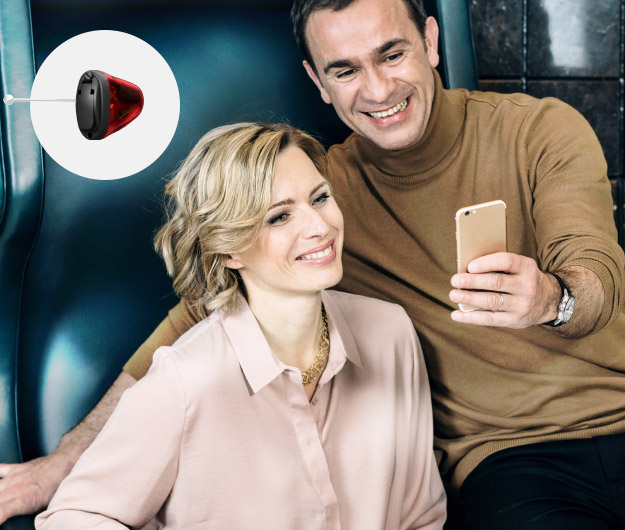Effective Treatments for Hearing Loss and Improved Hearing

Advanced hearing loss treatment
Today we have more advanced options for treating hearing loss than ever before. In HearingLife, our certified hearing care professionals are trained to find the most optimal treatment for your unique hearing needs.
In case you have a hearing loss, we offer the latest in hearing technology to help you hear better. It starts with a thorough examination of your hearing.
5 steps to improving your hearing
Types of treatments for hearing loss
While a hearing loss cure is not available, there are highly effective treatments to manage and improve hearing loss. Although it cannot be reversed, hearing aids and other listening devices have proven to significantly enhance hearing and improve the quality of life.
After a hearing care professional understands your hearing needs and has conducted a hearing evaluation, your treatment options will be discussed. The most common treatment options are:
- Hearing aids
- Ear wax removal
- Medicine (antibiotics for infections and antihistamines for allergies)
- Cochlear implants
- Bone-anchored hearing systems
If hearing aids are recommended as part of your treatment plan, your hearing care professional will discuss the solutions available to you. There are many options available to suit your hearing and communication needs.

Begin your journey to better hearing today:
Book a free appointment
Take the first step to better hearing by scheduling an appointment. The appointment is free of charge with no obligation to purchase.
Hearing loss types and treatment
The main types of hearing loss (sensorineural and conductive) affect different parts of the ear, and the recommended treatment differs for each type. Additionally, there are other forms of hearing loss that are unique in their symptoms and treatment options. You can read about standard treatment options for each by clicking on the hearing loss types and causes below.
Did you know?
Getting your hearing evaluated and treated with hearing aids is easy and painless. In fact, most hearing aid users regret that they didn't seek treatment sooner.
Consequences of untreated hearing loss

Benefits of treating your hearing loss
Treating your hearing loss has a wide range of proven benefits:
- Better communication
- Improved social engagement
- Improved quality of life
- Improved performance at work
- Increased levels of confidence
Discover hearing aid styles for all degrees of hearing loss
Knowing your level of hearing loss is an important step to understanding what might qualify as the best hearing aid for you. No matter your level of hearing loss, your hearing care professional will discuss the options available to suit your specific needs.
Level of hearing loss
Behind-the-ear Plus + Ultra Power |
Completely-in-the-canal |
In-the-canal |
Half/Full shell in-the-ear |
miniRITE (Receiver-in-the-ear) |
miniRITE R (Receiver-in-the-ear) |
Invisible-in-the-canal |
|
| Mild to moderate hearing loss |
✔ |
✔ | ✔ |
✔ | ✔ | ✔ | ✔ |
| Severe hearing loss |
✔ | ✗ | ✗ | ✔ | ✔ | ✔ |
✗ |
| Profound hearing loss |
✔ | ✗ | ✗ | ✗ | ✗ | ✗ | ✗ |
Mild to moderate hearing loss
When finding a hearing aid to treat mild to moderate hearing loss, there are a wide range of hearing aid styles to choose from. Both in-the-ear and behind-the-ear hearing aid styles are suitable, and the features can be personalized based on your preferences.
Severe hearing loss
In the case of severe hearing loss, behind-the-ear hearing aids are the most common hearing aid type used to treat this type of hearing loss, due to the fact that they typically have the battery power and technology required to effectively treat severe hearing loss. Full shell in-the-ear hearing aids may also be an option, depending on your hearing needs. No matter the option you choose, the features in the hearing aid can be catered to your personal needs.
Profound hearing loss
For those with profound hearing loss, if a powerful behind-the-ear hearing aid does not significantly improve the ability to hear in everyday life, then a hearing care professional may recommend surgical solutions such as cochlear implants or bone-anchored hearing systems.
Read our 3-step guide to finding the best hearing aid for your needs
FAQ about treating hearing loss
Sources
1. Beck D.L. (2012) British Academy of Audiology. Podium presentation
2. Clason, D. (2017, July 13). Can allergies affect your ears and cause hearing loss? Healthy Hearing. https://www.healthyhearing.com/report/51352-Can-allergies-cause-hearing-loss.
3. Clason, D. (2020, January 21). Dual sensory impairment: Hearing loss and vision loss. https://www.healthyhearing.com/report/52555-How-hearing-loss-is-different-than-losing-your-vision.
4. Clason, D. (2019, October 29). Sensorineural hearing loss (SNHL) causes. Healthy Hearing. https://www.healthyhearing.com/report/50276-Common-causes-of-sensorineural-hearing-loss.
5. G Livingston, Jonathan Huntley, Andrew Sommerlad, et al. Dementia prevention, intervention, and care: 2020 report of the Lancet Commission. The Lancet. July 30, 2020.
6. Frank R. Lin, M. D. (2011, February 1). Hearing Loss and Incident Dementia. Archives of Neurology. https://jamanetwork.com/journals/jamaneurology/fullarticle/802291.
7. Hearing Industries Association. (2019, March 27). MT10: MarkeTrak 10. Marketing Research, Inc.
8. Hearing Loss Association of America. (2018, May). Do you think you have hearing loss? https://www.hearingloss.org/wp-content/uploads/HLAA_DoYouThinkYouHave_Hearing-Loss.pdf?pdf=DoYouThink
9. Juul Jensen (2018). Closing a gap to normal hearing. Oticon White Paper.
10. Juul Jensen (2019). Oticon Opn S Clinical Evidence. Oticon White Paper.
11. Mroz, M. (2020, May 4). Hearing loss types - Learn about sensorineural, conductive and mixed. Healthy Hearing. https://www.healthyhearing.com/help/hearing-loss/types.
12. Oticon Opn S™ Hearing Aids l Oticon. https://www.oticon.com/breaking-the-rules.
13. Santurette, S., Ng, E. H. N., Juul Jensen, J., & Man K. L., B. (2020). Oticon More clinical evidence. Oticon Whitepaper.
14. U.S. Department of Health and Human Services. (2020, December 14). Sudden Deafness. National Institute of Deafness and Other Communication Disorders. https://www.nidcd.nih.gov/health/sudden-deafness.
15. U.S. Department of Health and Human Services. (2020, December 14). Noise-Induced Hearing Loss. National Institute of Deafness and Other Communication Disorders. https://www.nidcd.nih.gov/health/noise-induced-hearing-loss.
16. Victory, J. (2020, April 7). Bone-anchored hearing systems: What you need to know. Healthy Hearing. https://www.healthyhearing.com/help/hearing-aids/bone-anchored.
17. Victory, J. (2021, February) )Sudden hearing loss in one ear. Healthy Hearing. https://www.healthyhearing.com/report/52462-Sudden-hearing-loss-getting-to-the-bottom-of-it












